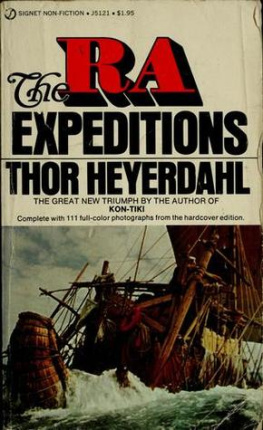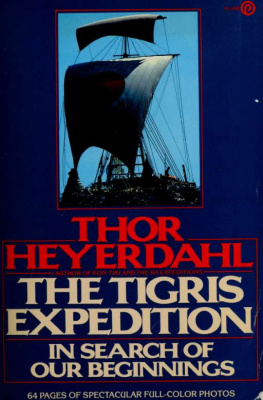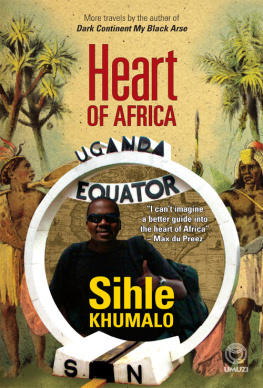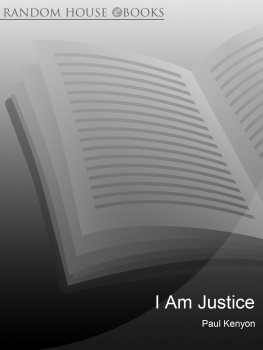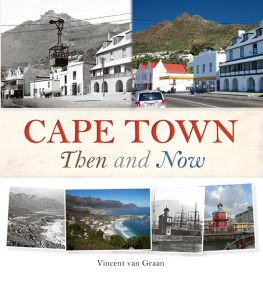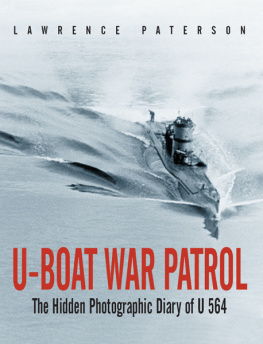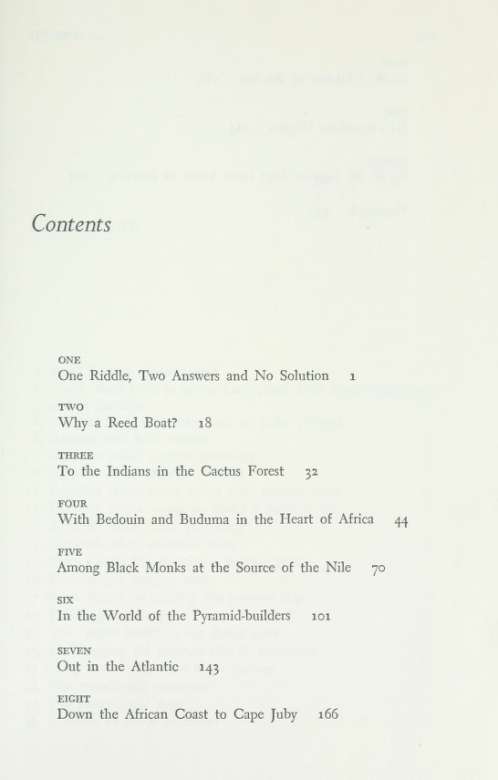To Yvonne
NINE
In the Clutches of the Sea 188
TEN
Into American Waters 224
ELEVEN
Ra 11. By Papyrus Boat from Africa to America 285 Postscript 337
1. Reed boat of Easter Island
2, 3, 4, 5. Reed boats in use on Lake Chad, Lake Zwai, Lake Tana and in Sardinia
6, 7. Reed boats in Mexico and on Lake Titicaca
8. Ancient reed boat models
9. Egyptian relief: papyrus gathering
10. Egyptian relief: papyrus binding
11. Egyptian relief: naval action with papyrus boats
12. Egyptian mural: noble on board a papyrus raft
13. Egyptian relief: cattle freighting
14. Egyptian relief: straddled mast
15. Bjorn Landstrom drawing a papyrus boat
16. Examining a papyrus reed
17 to 22. Stages in building the papyrus ship
23. Finishing the stern
24. The ''paper boat" on the desert sand
25. 26. Dragging the papyrus ship to the water 27 to 33. Seven men from seven nations
34. The expeditions members
35. The participants' flags
36. A model of Ra is presented
37. The naming ceremony at Safi
38. Yuri checking the provisions
39. Stowing the wooden boxes in the cabin
40. Egyptian hardtack
41. Some of the 160 ceramic storage jars
42. The Ra leaves Safi harbor
43. Bon voyage by rocket and siren
44. Steerage gear of the Ra
45. On the open Atlantic
46. The sail is hoisted
47. Under full sail
48. Alone on the ocean
49. Experimenting with rigging and steering gear
50. Streaming sea anchors
51. Splicing the broken rudder-oars
52. Norman with his sextant
53. Safi the monkey
54. Slicing salt meat
55. A broken jar of nuts
56. Eggs preserved in lime paste
57. The galley
58. Jar damaged by chafing
59. 60. Flying fish on board
61. A dorado caught by the author
62. Lunch round the chicken coop
63. The author's "nosometer**
64. Norman operating the transmitter
65. Changing watch
66. Basket cabin interior
67. Georges trims Santiago's hair
68. 69. The steering oar breaks again
70. Norman at the masthead
71. Yuri shaving
72. 73. Atlantic pollution
74. Papyrus life belt
75. Georges teaching Abdullah to write
76. African Neptune crossing our bow
77. Sack sent by African Neptune
78, 79. The sack's contents
80, 81. Ra photographed from African Neptune
82. Shipboard feast at halfway point
83. Chart of a month's voyage
84. Opposite list from ordinary boats
85. Problems begin aft
86. The after deck sags
87. Abdullah praying
88. The afterdeck submerges
89. The life raft is cut up
90. Carlo helps secure the sea anchor
91. Abdullah's magic remedies
92. Georges and Abdullah fixing bulwarks
93. Abdullah discovers the sea is salt
94. New bunk sites
95. Sharks gather
96. Results of the last storm
97. Norman and author at the receiver
98. An American yacht arrives
99. The Ra as seen from the yacht
100. The mast is cut away
101. Everything of value transferred to yacht
102. Starboard side under water
103. Port side undamaged
104. 105. Farewell Ra
106. Thanks for the ride, Ra
107. Ra II at sea
108. Madani Ait Ouhanni from Morocco
109. Kei Ohara from Japan
110. Ra II under gray skies
111. Ra II at nightfall
THE RA EXPEDITIONS
Chapter One
ONE RIDDLE, TWO ANSWERS AND NO SOLUTION
/V REED flutters in the wind.
We break it off.
It floats. It can bear a frog.
Two hundred thousand reeds flutter in the wind. A whole meadow billows like a green cornfield along the shore.
We cut it down. We tie it into bundles, like great corn sheaves. The bundles float. We go on board. A Russian, an African, a Mexican, an Egyptian, an American, an Italian, and myself a Norwegian, with a monkey and a lot of clucking hens. We are off to America. We are in Egypt. It's blowing sand, it's dry and hot, it's the Sahara.
Abdullah assures me that the reeds will float. I tell him that America is a long way off. He does not think people like black skins in America, but I assure him he is wrong. He does not know where America is, but we will get there in any case, if the wind is blowing that way. We will be safe on the reeds as long as the ropes hold. As long as the ropes hold, he says. Will the ropes hold?
I felt someone shaking me by the shoulder and woke up. It was Abdullah. "It's three o'clock," he said. "We are starting work again." The sun was baking inside the hot tent canvas. I sat up and peered through a gap in the door opening. The dry heat and blinding sunshine of the Sahara thrust at me from outside. Sun, sun, sun. A
sun-soaked expanse of sand met the bluest thing God has created, a cloudless desert sky unfolding in the afternoon sunshine above a world of golden-gray sand.
A row of three large and two small pyramids were set like shark's teeth against the arch of sky. They had stood so, motionless and unchanging, since the time when men were part of nature and built in accord with nature. And in front of them, down in the shallow depression, lay something timeless, built yesterday, built ten thousand years ago: a boat in the desert sand, a sort of Noah's ark stranded in the wilderness of the Sahara, far from surf and seaweed. Two camels stood beside it, chewing. What were they chewing? Trimmings from the boat itself, perhaps, "the paper boat." It was built of papyrus. The golden reeds were lashed together in bundles taking the form of a ship with prow and sternpost which stood out against the blue sky like a recumbent crescent moon.
Abdullah was already on his way down there. And two coal-black Budumas in fluttering white robes were clambering on board, while Egyptians in colorful garments dragged up fresh bundles of papyrus reed. There was work to be done. "Bot! Botl" shouted Abdullah. "More reeds!" I staggered out onto the hot sand as if I had awakened from a thousand-year sleep. After all, they were working for me, it was I who had conceived the absurd idea of reviving a boatbuilder's art that the Pharaoh Cheops and his generation were already beginning to abandon at the time they ordered the building of those mighty forms, the pyramids which now stood there like a solid mountain range, hiding our timeless shipyard from the twentieth-century maelstrom whirling in Cairo's hectic city streets down in the green Nile Valley on the other side.
Our world, outside the tents, was bare sand. Hot sand, pyramids, more sand, and huge stacks of sun-dried reeds, brittle, combustible papyrus reeds, which the men were dragging over to the licorice skinned boatbuilders who sat on the crescent moon, tightening rope lashings with the aid of hands, teeth and naked feet. They were building a boata papyrus boat. A kaday they called it in their Buduma tongue, and they knew what they were building. Busy fingers and teeth strapped the loops round the reeds as only experts could. "A paper boat," said the people at the Papyrus Institute down in the Nile Valley. For there they soaked these reeds in water and

